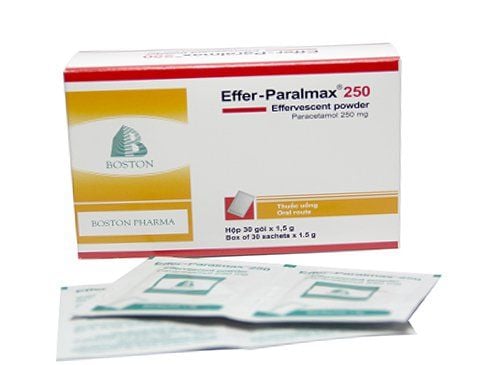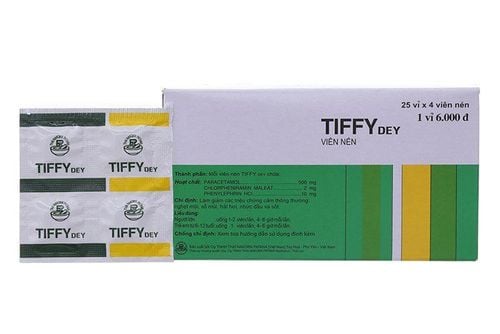This is an automatically translated article.
The normal temperature in infants and children is around 36.4 °C, but this can vary slightly. A high temperature or fever in a child is usually 38°C or higher. Your baby may have a high body temperature if: feels hotter than usual to the touch of his forehead, back, or belly, feels sweaty, or has rosy cheeks. If you think your baby has a high temperature, it's best to check your baby's temperature with a thermometer. This can help you figure out if you need medical advice. So how to measure the baby's temperature will give accurate results? In this article, we will provide caregivers with useful methods for determining a child's basal body temperature.1. What type of thermometer should be used to measure the child's temperature?
If you suspect your baby has a fever, it's important to accurately determine the child's body temperature, so parents should always have a good digital thermometer in their home. Conventional reusable digital thermometers are sold in pharmacies at relatively cheap prices. They are easy to use, easy to read and give faster results than classic thermometers. Typically, a digital thermometer can give results within 10 seconds or as little as 2 minutes. There are many types of thermometers that can be used to take a baby's temperature, such as rectal, oral or underarm thermometers, although taking a baby's temperature by mouth is not a good option for children under 4 years of age. If using a reusable thermometer, mothers should consider only using it in a certain area to avoid the spread of bacteria.Rectal temperature measurement is the most accurate method and the best tool to do this is a rectal thermometer, specially designed for this method. Mothers should be careful to look for one with a soft tip and wide handle that will allow the thermometer to penetrate not too deeply to puncture the baby's rectum.
Several methods of measuring body temperature at a higher price point include temporal artery thermometers, which use infrared scanners to take baby's temperature with just a swipe of the forehead, and ear thermometers may be more difficult to use. Doctors say other temperature measuring tools, such as pacifier thermometers and temperature-sensitive strips placed on babies' foreheads, often give inaccurate results.
No matter which method you choose, there are a few points to keep in mind when taking your baby's temperature, that is, do not take the temperature immediately after bathing (when the baby's body temperature may temporarily rise), wait a little longer. At least 20 minutes after bathing for an accurate reading, and do not take rectal temperature when unswaddled.
Note that old-fashioned glass thermometers can break and leak toxic mercury and are no longer recommended for use in children.
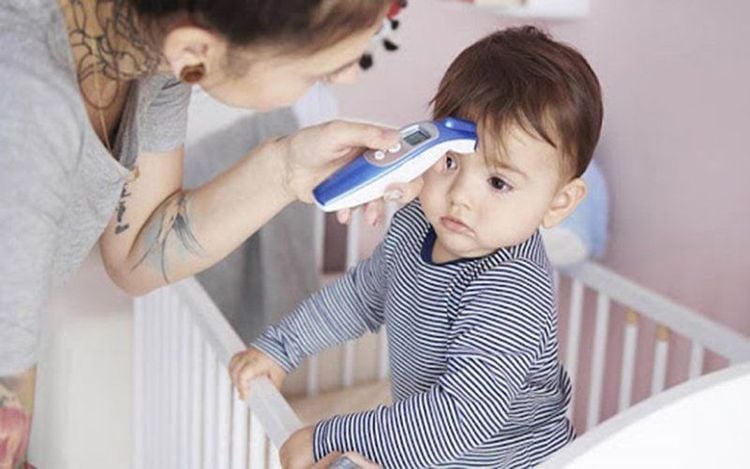
Nếu nghi ngờ bé đang bị sốt, điều quan trọng cần làm là xác định chính xác nhiệt độ cơ thể của trẻ
2. How to use a rectal thermometer
Some babies don't mind taking their temperature rectally so it can go smoothly, but some babies don't, they just seem to hate it. If your baby is fussy and doesn't want to take his rectal temperature, take his or her armpit temperature. If the reading is above 37.5°C, take the temperature rectally for more accurate results.To prepare for the measurement, clean the end of the thermometer with rubbing alcohol or soap. Rinse with water then apply a little mineral oil to make it easier to put into the baby's anus. Place the child on his or her back on the bed, legs bent over the chest. In addition, mothers can also choose the position of holding their baby horizontally in their lap, pulling the belly from top to bottom so that the baby's legs are over one side of the mother's thigh.
Press the button to turn on the thermometer. Gently insert the tip of the thermometer into your baby's rectum. Hold the baby's bottom firmly by using the palm and fingers holding the thermometer. Don't let go of the thermometer because it could end up in the wrong place when the baby starts to squirm. When the thermometer beeps, take it out and read the value displayed on the screen. Don't be surprised that your baby may poop as soon as you remove the thermometer because anything inserted into the rectum can stimulate the baby's bowel movements. Clean the thermometers with soap or alcohol, then dry them before storing them away for the next measurement.

Một số trẻ sơ sinh không ngại việc đo nhiệt độ qua trực tràng do đó quá trình đo có thể diễn ra suôn sẻ
3. How to use the temporal artery thermometer
Temporal artery thermometers are easy to use, just be sure to read and follow the instructions carefully before using them. Instructions for use can be found in the thermometer's box, on the manufacturer's website, or directed by your physician.The basic measurement technique of this method consists of placing the thermometer flat on the child's forehead between the eyebrows and the hairline. Press the button and let the thermometer in contact with the baby's skin, swipe the thermometer in a horizontal line on the forehead (be careful not to swipe down the face). Still holding the thermometer button, then lift it from the forehead then release the button and proceed to read the temperature displayed on the screen.
How the temporal artery thermometer determines temperature or how it works is relatively complicated, but basically basal temperature readings are based on an artery located near the surface of the skin in the child's forehead.
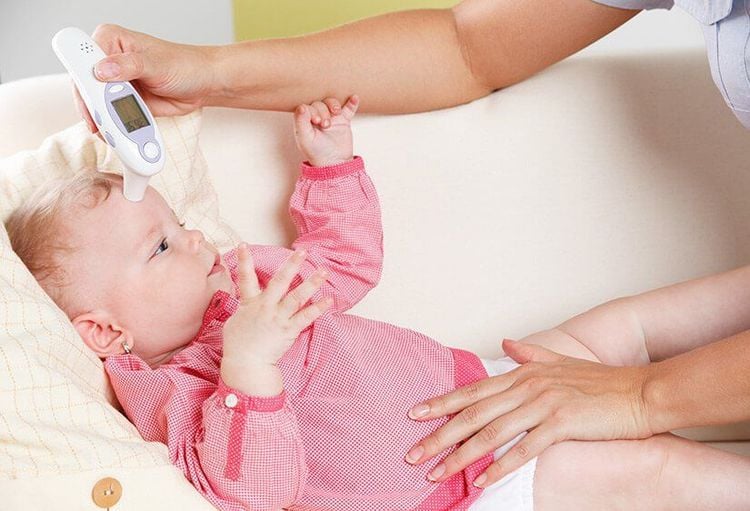
Nhiệt kế động mạch thái dương rất dễ sử dụng, chỉ cần lưu ý đọc kỹ và làm theo hướng dẫn trước khi dùng
4. How to measure a child's armpit temperature
Some doctors recommend that parents take their baby's armpit temperature. That's why there are thermometers designed to do this job. Taking an armpit temperature is one of the easiest, most convenient and safest methods for babies. All moms need is an ordinary digital thermometer.The disadvantage of the axillary temperature method for children is that the results are often much less accurate than other methods. The temperature readings in the armpits and other areas of the skin on the outside of the body can be about 2 degrees lower than the ones inside the rectum. The American Academy of Pediatrics (APP) says it's better not to use this method on babies under 3 months of age, when an accurate temperature reading is essential and most important.
For the method of measuring the baby's armpit temperature, the first step is to pull the baby's shirt from the waist up and lift the baby or place the baby on the parent's lap. Try to keep your baby comfortable by letting them play with toys or watch a favorite TV show. Make sure the skin under your baby's arms is dry, then insert the thermometer bulb into your baby's armpit. The tip of the thermometer should be in full contact with your baby's skin, so keep your baby's arm against the side or bend and flex at chest level. When the thermometer beeps, take out the thermometer and read the result displayed on the screen.
5. How to use an ear thermometer to measure a child's temperature
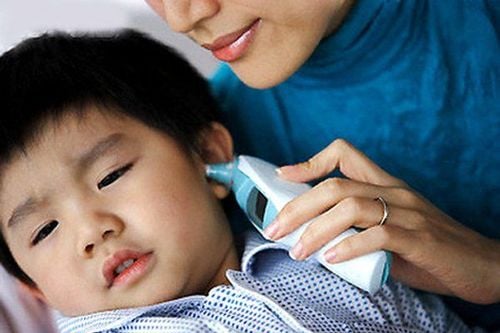
Nhiệt kế đo tai nhìn chung là nhanh chóng, an toàn và không gây khó chịu cho trẻ
If parents choose this method to take the baby's temperature, ask the doctors directly about how to use this thermometer or practice measuring according to the instructions that come with the thermometer until it is obtained. suitable results. In addition, mothers can also compare the difference between the temperature measured in the ear and the temperature measured in the baby's rectum to be able to approximate the baby's body temperature.
Ear thermometers are not recommended for children under 6 months old because the ear canals of children at this stage are still narrow, making it difficult to install the sensor.
Fever is just a symptom of a certain disease but it is an important sign. Especially in this current period when the COVID-19 (SARS-CoV-2) pandemic is still going on, parents may need to pay attention to all of their baby's smallest symptoms, including: fever before sending your child to school, child care, or other outdoor activities. Feeling the temperature by touching a child's forehead can be very quick and easy, but it is not accurate. Therefore, each family should still prepare a separate digital thermometer for use in necessary cases. Most of them give quick results and are very easy to use.
When taking the child's temperature, it is found that the child's body temperature is too high or the fever is accompanied by many unusual symptoms such as convulsions, rashes,... Parents should quickly take their children to the centers reputable medical center for timely examination and treatment.
To prevent diseases that babies often get, parents should pay attention to nutrition to improve children's resistance. At the same time, add supporting foods containing lysine, essential micro-minerals and vitamins such as zinc, chromium, selenium, B vitamins,... snacks and less digestive problems.
Parents can learn more:
Why do you need to supplement Lysine for your baby?
The role of zinc - Guidelines for reasonable zinc supplementation
Please visit the website Vinmec.com regularly and update useful information to take care of your baby and family.
References: babycenter.com, healthychildren.org




